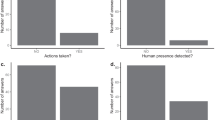Abstract
In this research, we suggest a framework for the detail wildlife monitoring based on video surveillance. Camera traps are located on the remote territories of natural parks in the habitats of wild animals and birds. In spite of the dominant connectivity and sensing technology for wildlife monitoring are based on the wireless sensor networks, such technology cannot be applied in some cases due to vast impassable territories, especially in Siberian part of Russia. Based on our previous investigations in this research topic, we propose the main approaches and methods for big data collection, processing, and analysis useful for the management of natural parks and any wildlife habitat.
Access this chapter
Tax calculation will be finalised at checkout
Purchases are for personal use only
Similar content being viewed by others
References
Frair, J., Nielsen, S., Merrill, E., Lele, S., Boyce, M., Munro, R., Stenhouse, G., Beyer, H.: Removing GPS collar bias in habitat selection studies. J. Appl. Ecol. 41(2), 201–212 (2004)
Burton, C.A., Neilson, E., Moreira, D., Ladle, A., Steenweg, R., Fisher, J.T., Bayne, E., Boutin, S.: Wildlife camera trapping: a review and recommendations for linking surveys to ecological processes. J. Appl. Ecol. 52, 675–685 (2015)
Zhang, J., Luo, X., Chen, C., Liu, Z., Cao, S.: A wildlife monitoring system based on wireless image sensor networks. Sens. Trans. 180(10), 104–109 (2014)
Tibbetts, J.H.: Remote sensors bring wildlife tracking to new level: trove of data yields fresh insights–and challenges. Bioscience 67(5), 411–417 (2017)
Zviedris, R., Elsts, A., Strazdins, G., Mednis, A., Selavo, L.: LynxNet: wild animal monitoring using sensor networks. In: Marron, P.J., Voigt, T., Corke, P., Mottola, L. (eds.) Real-World Wireless Sensor Networks: 4th International Workshop, LNCS, vol. 6511, pp. 170–173. Colombo, Sri Lanka (2010)
Xu, J., Solmaz, G., Rahmatizadeh, R., Turgut, D., Boloni, L.: Internet of things applications: Animal monitoring with unmanned aerial vehicle. In: 40th Annual IEEE Conference on Local Computer Networks, pp. 125–132 Florida, USA (2015)
Zhang, J., Zhang, J., Du, X., Hou, K., Qiao, M.: An overview of ecological monitoring based on geographic information system (GIS) and remote sensing (RS) technology in China. In: IOP Conf. Series: Earth and Environmental Science 94, 012056.1–012056.4 (2017)
Madheswaran, K.M.S., Veerappan, K., Kumar, S.V.: Region based convolutional neural network for human-elephant conflict management system. In: International Conference on Computational Intelligence in Data Science, pp. 1–5. Chennai, India (2019)
Nguyen, H., Maclagan, S.J., Nguyen, T.D., Nguyen, T., Flemons, P., Andrews, K., Ritchie, E.G., Phung, D.: Animal recognition and identification with deep convolutional neural networks for automated wildlife monitoring. In: IEEE International Conference on Data Science and Advanced Analytics, pp. 40–49. Tokyo, Japan (2017)
Norouzzadeh, M.S., Nguyen, A., Kosmala, M., Swanson, A., Palmer, M.S., Packer, C., Clune, J.: Automatically identifying, counting, and describing wild animals in camera-trap images with deep learning. Proc. Natl. Acad. Sci. U.S.A. 115(25), E5716–E5725 (2018)
Chen, R., Little, R., Mihaylova, L., Delahay, R., Cox, R.: Wildlife surveillance using deep learning methods. Ecol. Evol. 9(17), 9453–9466 (2019)
Favorskaya, M., Pakhirka, A.: Animal species recognition in the wildlife based on muzzle and shape features using joint CNN. Procedia Comput. Sci. 159, 933–942 (2019)
Favorskaya, M., Buryachenko, V.: (2019) Selecting informative samples for animal recognition in the wildlife. In: Czarnowski, I., Howlett, R., Jain, L. (eds.) Intelligent Decision Technologies SIST, vol. 143, pp. 65–75. Springer, Singapore (2019)
Favorskaya, M.N., Buryachenko, V.V.: Background extraction method for analysis of natural images captured by camera traps. Inf. Control Syst. 6, 35–45 (2018)
Zotin, A.G., Proskurin, A.V.: Animal detection using a series of images under complex shooting conditions. In: ISPRS—International Archives of the Photogrammetry, Remote Sensing and Spatial Information Sciences. XLII-2/W12, pp. 249–257 (2019)
Nicheporchuk, V.V., Penkova, T.G., Gryazin, I.V.: Structuring the information resources for intelligent ecosystem monitoring system based on camera traps. In: 42nd International Convention on Information and Communication Technology, Electronics and Microelectronics, pp. 1449–1454. Opatija, Croatia (2019)
Acknowledgements
The reported study was funded by Russian Foundation for Basic Research, Government of Krasnoyarsk Territory, Krasnoyarsk Regional Fund of Science, to the research project No 18-47-240001.
Author information
Authors and Affiliations
Corresponding author
Editor information
Editors and Affiliations
Rights and permissions
Copyright information
© 2020 The Editor(s) (if applicable) and The Author(s), under exclusive license to Springer Nature Singapore Pte Ltd.
About this paper
Cite this paper
Nicheporchuk, V., Gryazin, I., Favorskaya, M.N. (2020). Framework for Intelligent Wildlife Monitoring. In: Czarnowski, I., Howlett, R., Jain, L. (eds) Intelligent Decision Technologies. IDT 2020. Smart Innovation, Systems and Technologies, vol 193. Springer, Singapore. https://doi.org/10.1007/978-981-15-5925-9_14
Download citation
DOI: https://doi.org/10.1007/978-981-15-5925-9_14
Published:
Publisher Name: Springer, Singapore
Print ISBN: 978-981-15-5924-2
Online ISBN: 978-981-15-5925-9
eBook Packages: Intelligent Technologies and RoboticsIntelligent Technologies and Robotics (R0)




